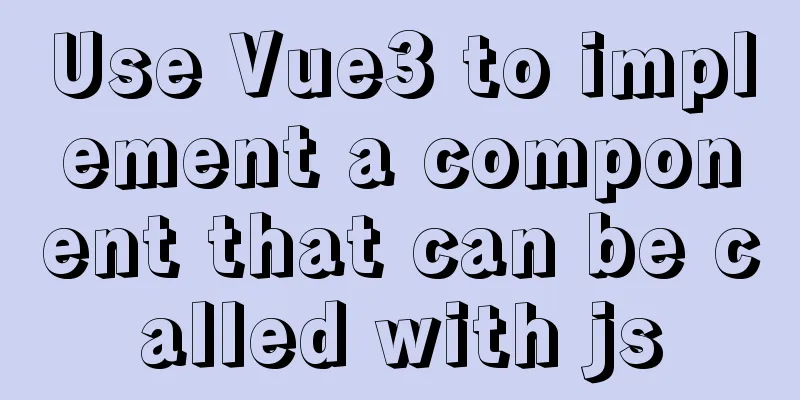Use Vue3 to implement a component that can be called with js

PrefaceComponent libraries are basically used in project development, but the style and functions of the design draft may not be the same as those of the component library, especially for message prompt pop-ups and confirmation pop-ups. Each project and each designer has his own style. Although we can use the components in the component library to override its style. However, some customized functions are still not easy to modify. In this case, we will choose custom components, and then introduce them into the page through the components attribute, and explicitly write tag calls. For message prompts that give users simple prompts or operations, most commonly used UI libraries support similar functions through js calls. We can also refer to the calling method of the UI library to implement a custom component called by a js function. 1. Conventional Vue components Suppose we need to implement a confirmation box, click a button to open the confirmation box, click the OK and Cancel buttons of the confirmation box to close the confirmation box, and call the corresponding method. 1. Main component code:src/components/Confirm/Confirm.vue
2. Usage
3. Achieve results
2. Change to js call componentThe above method of calling components is very cumbersome. It requires both introduction and processing of callbacks of various operations. In addition, the component DOM node is inserted under the current page, and the style may be overwritten by the component content or affected by other factors. The result we want to achieve is: calling the component through a js function, the function returns a promise, confirms then, and cancels catch`, for example:
Confirm({
title: '',
message: ''
}).then(() => {
// Click to confirm}).catch(() => {
// Click to cancel })
1. Implementation steps:
2. Specific implementation code:Modify the Confirm component js part and pass onConfirm and onCancel from props to facilitate the use of component instances.
// src/components/Confirm/Confirm.vue
<script>
export default {
name: 'Confirm',
props: {
title:
type: String,
default: 'prompt'
},
message: {
type: String,
default: 'Default prompt message'
},
confirmBtnText: {
type: String,
Default: 'Confirm'
},
cancelBtnText: {
type: String,
default: 'Cancel'
},
onConfirm: {
type: Function,
default: () => {}
},
onCancel: {
type: Function,
default: () => {}
}
}
}
</script>
Create a new index.js file in the same directory, pass parameters such as onConfirm and onCancel to the component through props, and you can receive event callbacks in the instance.
// src/components/Confirm/index.js
import { createApp } from 'vue'
import Confirm from './Confirm'
function confirm ({ title, message, confirmBtnText, cancelBtnText }) {
return new Promise((resolve, reject) => {
// Instantiate the component, the second parameter of createApp is props
const confirmInstance = createApp(Confirm, {
title: title || 'Tips',
message: message || 'Confirm message',
confirmBtnText: confirmBtnText || 'Confirm',
cancelBtnText: cancelBtnText || 'Cancel',
onConfirm: () => {
unmount()
resolve()
},
onCancel: () => {
unmount()
reject(new Error())
}
})
// Unmount component const unmount = () => {
confirmInstance.unmount()
document.body.removeChild(parentNode)
}
// Create a mounting container const parentNode = document.createElement('div')
document.body.appendChild(parentNode)
//Mount component confirmInstance.mount(parentNode)
})
}
export default confirm
Using Components
setup () {
const showConfirm = () => {
Confirm({
title: 'Title',
message: 'Content'
}).then(() => {
console.log('Click to confirm')
}).catch(() => {
console.log('Click to cancel')
})
}
return {
showConfirm
}
}
3. Realize the effect display
SummarizeThis is the end of this article about using Vue3 to implement a component that can be called by js. For more relevant content about Vue3 implementing components called by js, please search for previous articles on 123WORDPRESS.COM or continue to browse the following related articles. I hope everyone will support 123WORDPRESS.COM in the future! You may also be interested in:
|
>>: Discussion on more reasonable creation rules for MySQL string indexes
Recommend
Solution to the problem of flash back after entering the password in MySQL database
MySQL database crashes after entering password an...
A brief analysis of MySQL explicit type conversion
CAST function In the previous article, we mention...
A simple ID generation strategy: Implementation of generating globally unique ID from MySQL table
There are many ways to generate a global ID. Here...
Summary of the application of transition components in Vue projects
Transtion in vue is an animation transition enca...
Detailed graphic tutorial on downloading and installing VirtualBox software and installing and deploying it in Linux environment
1. Download and install VirtualBox software First...
MySQL database Load Data multiple uses
Table of contents Multiple uses of MySQL Load Dat...
Collection of 25 fonts used in famous website logos
This article collects the fonts used in the logos...
Enable sshd operation in docker
First, install openssh-server in docker. After th...
How does MySQL implement ACID transactions?
Preface Recently, during an interview, I was aske...
Negative margin function introduction and usage summary
As early as in the CSS2 recommendations in 1998, t...
MySQL 5.7.18 free installation version window configuration method
This is my first blog. It’s about when I started ...
Perfect solution to the problem of data being truncated when using the group concat function in Mysql5.7
The day before yesterday, I encountered a problem...
Detailed explanation of the application of CSS Sprite
CSS Sprite, also known as CSS Sprite, is an image...
MySQL 5.7.10 winx64 installation and configuration method graphic tutorial (win10)
MySQL is a relatively easy-to-use relational data...
5 Reasons Why Responsive Web Design Isn’t Worth It
This article is from Tom Ewer's Managewp blog,...














